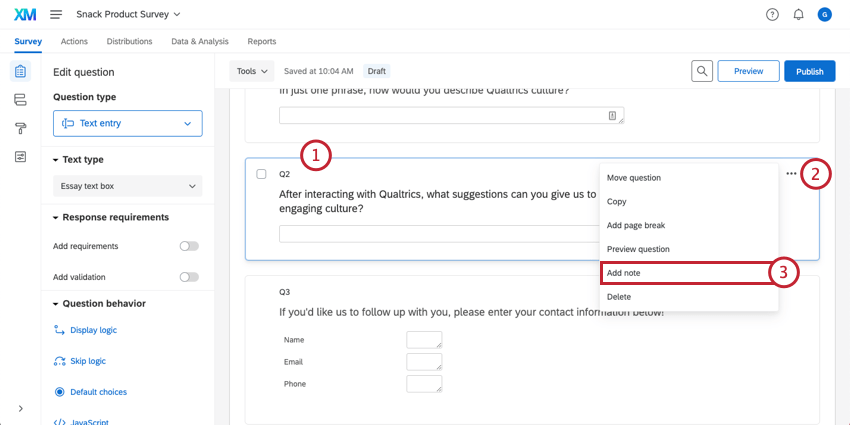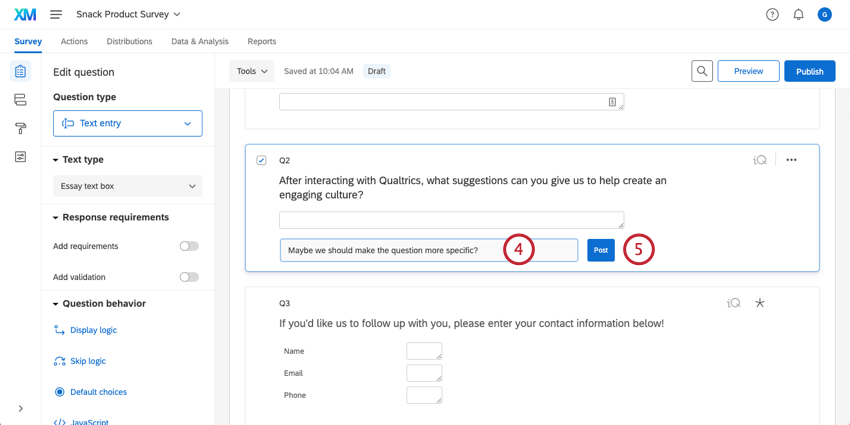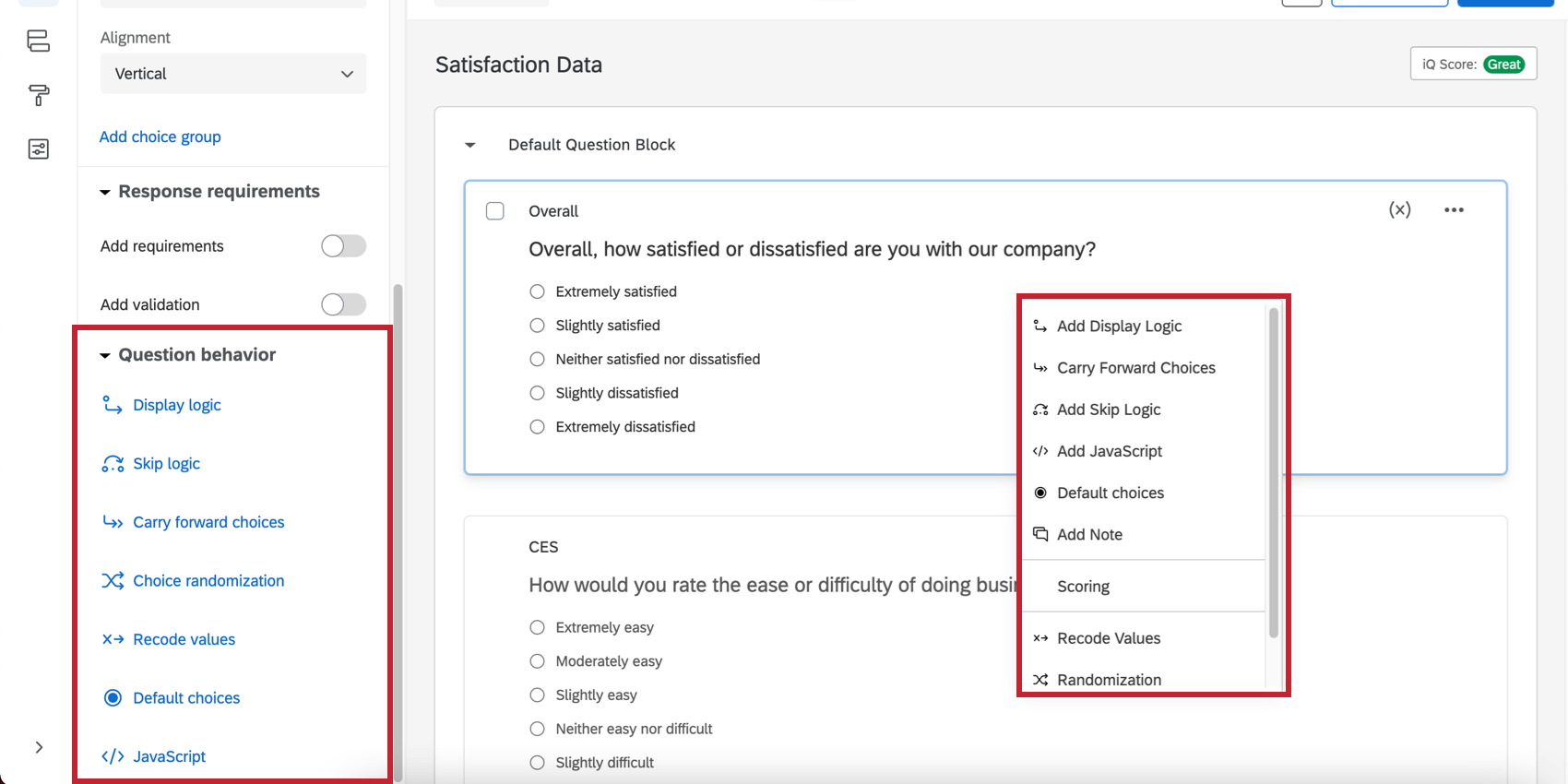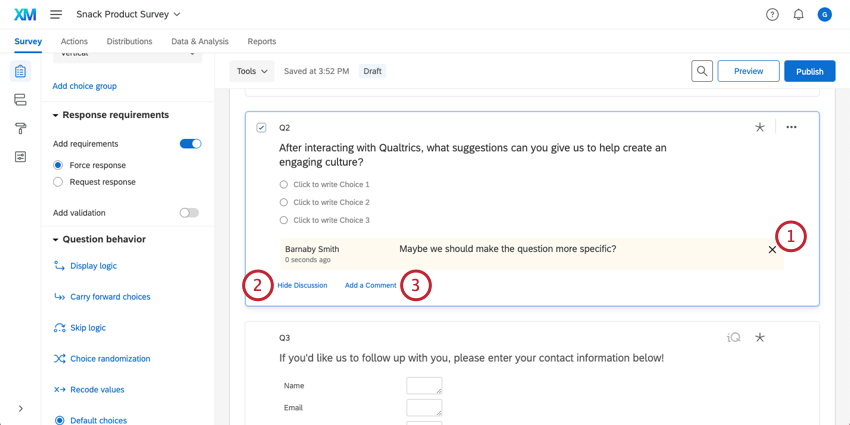Question Behavior
About Question Behavior
For each question in a survey, you can enable behavior that enhances your survey design, such as randomizing answer choices, hiding the question based on certain conditions, adding default choices, and more.
To access question behavior, either right-click on the question or use the Edit question pane to the left of your selected question.
Available Question Behavior
These options can be accessed in the leftmost Question behavior menu and by right-clicking on the question:
- Display logic: Show your question conditionally based on previous information.
- Skip logic: Send respondents to a future point in the survey based on how they answer the selected question.
- Carry forward choices: Carry forward allows you to copy specific answer choices from one question and bring them into a future question in your survey.
Attention: Carry Forward is not available for EX projects since it is incompatible with dashboard scales.
- Choice randomization / Randomization: Set your choices to display in a random order.
- Recode values: Use this option to change the default numeric values or variable names for your answer choices. The coding you set here will be reflected in your reports and raw data, and is used to calculate all statistics. Not all question types can be recoded, so this option won’t appear if it’s not one of the compatible types.
- Default choices: You can use default choices feature to pre-populate answer choices within a question when the respondent opens the survey.
- JavaScript: Add JavaScript to the selected question.
Warning: Custom coding features are provided as-is and may require programming knowledge to implement. Our support team does not offer assistance or consultation on custom coding. You can always try asking our community of dedicated users instead. If you’d like to know more about our custom coding services, please contact your Qualtrics Account Executive.
Additional options that appear when you right-click on the question:
- Add Note: Add comments to questions, either for your own benefit, or for other collaborators to see. These notes won’t be displayed on the survey itself.
- Scoring: Add scoring to a question. If a question can’t be scored, this option won’t appear.
- Add Choice Group: Group answer choices together. Only available for multiple choice and matrix table questions.
Adding & Removing Notes
If you’ve invited colleagues to collaborate on a survey with you, notes can be a good way to leave feedback and questions for each other while editing the survey.
Any notes you add to the survey are only visible to other people who can edit the survey. Respondents and those previewing the survey won’t see these notes. Notes can only be viewed within the survey editor, and can’t be exported.
Adding Notes
- Click on the question you wish to add a note to.

- Click the 3 horizontal dots to the right of the question.
- Select Add note.
- Type your note into the field.

- Click Post to add the note. You can also press Enter or Return on your keyboard.
Once the note is added, the first and last name of your account will be added next to it so collaborators can tell who left the note. There will also be a timestamp in the note.
Deleting Notes, Hiding Notes, and Adding More Notes
- Click the grey X to delete the comment. You can only delete your own comments.
- Click Hide Discussion to collapse the comments and only show the last comment of the discussion. This option only hides the thread for you, not everyone editing the survey. You can click Show Discussion to reopen the thread.
Qtip: This option is best for when there’s a long thread of comments that makes scrolling through the editor cumbersome.
- Click Add a Comment to add an additional comment.
Question Behavior in Different Project Types
This type of question behavior is available in many different types of projects. The options described on this page are available in:
There are a few other projects that have access to question behavior, but with unique functionality to keep in mind.
- For Pulse, see Features Available in Pulse Surveys.
- For 360 projects, see Question Behavior (360).
- For Conjoint and MaxDiff, see this support page.
FAQs
- Why are my recode values all out of order?
-
Recode values are assigned in the order the answer choices are created. Before you start collecting responses, these values will reset to always be in sequential order as long as you haven’t edited your recode values yet. As soon as you select Recode Values to enable editing them, the order of the choices will be assigned to include re-ordering and deletion.
After you collect your first response, the recode values won't automatically update to be in a sequential order so as to protect your collected data.
So, if you make three options—we'll say Red, Yellow, and Blue—your recode values initially are 1, 2, and 3. If you delete Yellow and add Orange, Orange is the fourth option and has a recode value of 4. Your recode values are now 1, 3, and 4. If you move Red so that it’s the last listed option, your recode values are now 3, 4, and 1.
However, you can change the recode values at any time without affecting your data. You will see the updated values the next time you download your data or view your results. - Why are my page breaks being ignored?
-
There are several settings that override page breaks:
- Questions per Page set in the Look and feel
- Question randomization set up in a block
- Skip logic, display logic, and carry forward (all 3 by default will insert a page break)
- Why is my HTML, CSS, and JavaScript not working in my free / trial account?
-
As a free / trial account, custom code is not enabled and so you won’t see it in preview and active versions of the survey. To use custom code, your account will need to be upgraded.
- I am having trouble setting up logic to display a question or set of questions to a specific subset of my respondents.
-
The three types of logic available in Qualtrics are display logic, branch logic, and skip logic. Each of them serve a unique purpose; understanding which type of logic to use enables you to customize each respondent’s survey experience. Display Logic displays or hides a question based on any information you already have about the current respondent. Branch Logic does the same but for blocks of questions or other Survey Flow elements. Finally, Skip Logic sends the respondent to a different part of the survey based on their answer to a specific question. For more details on how to set up your logic, check out our Using Logic support page.
- I want to hide or show questions for different respondents based on their answers or Embedded Data. How can I do this?
-
You can use Display Logic to create a customized survey experience for each respondent. When a specific question, answer choice, or embedded data field pertains only to certain respondents, you can set display logic to show it conditionally based on previous information. Through display logic, you can create surveys that dynamically adapt to your respondents’ answers.
- What are the numbers in my exported data file, and can I change them?
-
The numeric values in your exported data are the recode values associated with the answers choices in your survey. You can adjust these any time by finding the question in the survey editor, selecting the question options icon on the left side of the question, and choosing Recode Values. When you check Recode Values in this menu, you can edit these numbers and your edits will be reflected in any future data exports.
- I want to remove a question or answer choice from a survey, but I’ve already collected some data. What do I do?
-
Once you’ve collected data, we recommend never deleting a question or answer choice, as it could invalidate your data. Instead, you can use Display Logic to hide your question or answer choice so that respondents will not see it. See Hiding Questions with Display Logic for more information.

